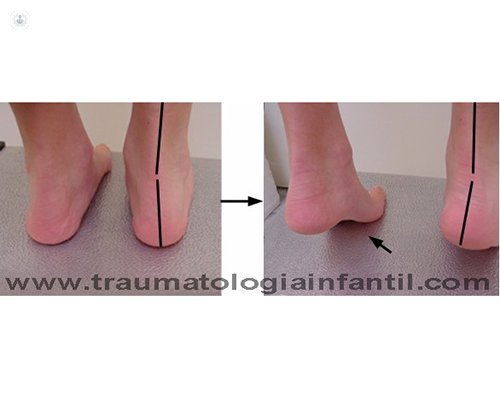You flat feet, what are they?
Written by:
What is the pathology of flat feet?
Usually we talk about flatfoot when there is a decrease in height of the longitudinal arch of the foot. It is generally accompanied by a deviation from the heel outward (what we call talus valgus) and therefore often called flat-valgus foot.
In children two types of flatfoot, flexible and rigid flatfoot flatfoot there basically.
The flexible flat foot is characterized by a foot with a normal skeletal structure but with a lot of flexibility in your joints. So when the child stands up and supports its weight, the bridge collapses and heel deviates outward. However, when we do put on tiptoe, reappears the bridge and the heel is placed corrected inward. This is the most common type of foot in children and is considered a normal situation during the first years of life.
The rigid flatfoot is characterized in that there are abnormal connections between the foot bones. This causes a deformity with lower height of the longitudinal arch and heel valgus. When the child stands on tiptoes, standing posture does not change because mobility is blocked by the union between bones. This situation is final and does not change with age.
How old is usually manifested?
Most children below 5 years usually have flexible flat feet. Also during the first two years of life is usually an accumulation of fatty tissue in the area of the longitudinal arch increases the appearance of flatfoot. Normally longitudinal arch height increases progressively the early years of life, by age 10 presents an appearance of normal foot and adolescence just completely formed.
However, there is a wide range of normality regarding the height of the longitudinal arch. Overall the girls usually have the bow more pronounced than boys. And in fact, up to 20% of the population never gets to develop a clear longitudinal arch and presents throughout life a flexible flat feet painless and functional. Therefore, now we consider the flexible flatfoot as a normal variant.
However, a flexible flatfoot very pronounced causes difficulties for footwear, friction on the inside and even pain with physical activities. These symptoms usually appears after age 10 and especially in adolescence, because standing mechanical load increases due to increased body weight as they usually do more physical activity.
Flatfoot rigid by abnormal bone joints not improve during growth and from 10 years can cause discomfort, often in the peroneal tendons (behind the fibula in the ankle) as contractured when trying to move some joints that are stiff for bone union. In addition, this bone union hinders the ability of the foot to adapt to uneven terrain and patients often have repeated ankle sprains. Therefore, given a child with sprained repetition should be studied not present bone alterations in the foot.
How I can tell if my child has flat feet?
Exploration is very simple. Should be placed behind the child and watch supports feet. If you notice the absence of longitudinal arch and a heel just wide outward, it is presenting a flat-valgus foot.
Then you should tell him to put on tiptoe. If in so doing, the longitudinal arch and heel appears corrected and placed in, it is a flexible flatfoot should not worry. If the stand on tiptoe, does not appear longitudinal arch and the heel is not corrected, it's probably a rigid flatfoot and should consult with pediatric orthopedist.

Flat feet do you have a solution? What is surgical treatment?
In general we believe that the flexible flatfoot not require treatment. The use of templates has proven to be effective to cause an increase of the longitudinal arch, but that their effect is the opposite, because by increasing the rigidity of the shoe sole, impedes the encouragement of development of internal muscles of the foot and its use is associated with persistence of flatfoot. It is generally recommended activities that develop internal intrinsic foot muscles, like walking on tiptoe, walk along the sandy beach or walk home barefoot (or with socks slip).
In cases of very accentuated flexible flat foot, painful or difficult for footwear, there are several reconstructive surgical options. The simplest is to place a rigid support between the talus and calcaneus bones avoiding subsidence of the longitudinal arch and heel valgus deformity. Generally this support remains a couple of years and then removed. In severe cases there are other more complex reconstructive techniques.
In cases of symptomatic little rigid flatfoot is usually sufficient rehabilitation treatment to reverse the contracture of the peroneal muscles. If there are very repetitive strain or pain that does not yield to rehabilitation treatment, it has to raise a surgical resection of abnormal bone union.


